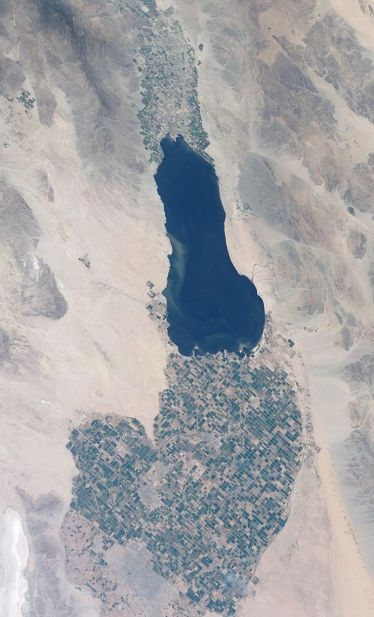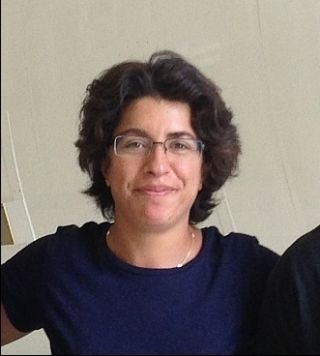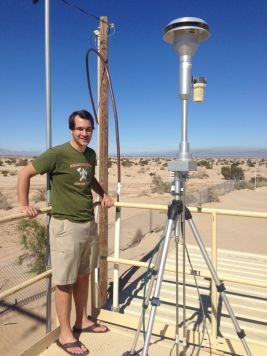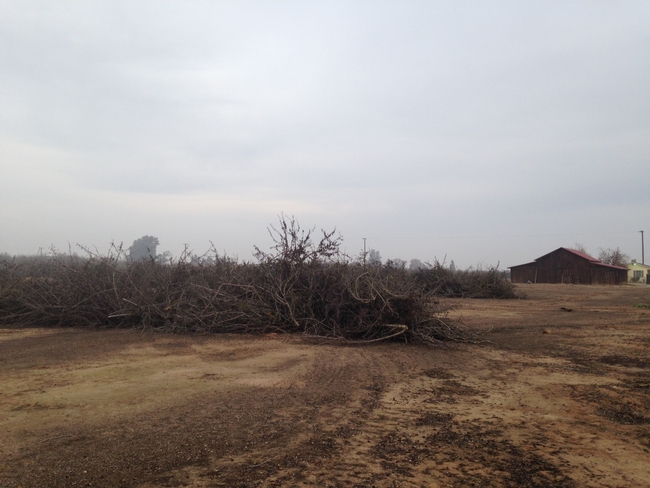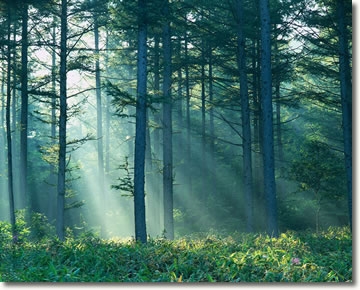Posts Tagged: air
New dust sources resulting from a shrinking Salton Sea have negative ecological and health impacts
UC Riverside study shows soils once submerged under the sea and airborne particulate matter are high in sodium and selenium
Scientists at UC Riverside investigating the composition of particulate matter (PM) and its sources at the Salton Sea have found that this shrinking lake in Southern California is exposing large areas of dry lakebed, called playa, that are acting as new dust sources with the potential to impact human health.
“Playas have a high potential to act as dust sources because playa surfaces often lack vegetation,” said Roya Bahreini, an associate professor of environmental sciences, who led the research project. “Dust emissions from playas increase airborne PM mass, which has been linked to cardiovascular disease, respiratory disease, and mortality.”
Study results appeared recently in Environmental Science and Technology.
Bahreini's team set out to test whether emissions from playas change the composition of PM10 (particulate matter with diameters up to 10 microns) near the Salton Sea. The team assessed the composition of playa soils (recently submerged underneath the Salton Sea), desert soils (located farther from the sea), and PM10 collected during August 2015 and February 2016.
They found that dust sources contributed to about 45 percent of PM10 at the Salton Sea during the sampling period while playa emissions contributed to about 10 percent. Further, they found that playa emissions significantly increased the sodium content of PM10.
“Increase in the sodium content of PM10 can affect the ecosystem when the sodium-rich particles deposit downwind and change the natural balance for soils and agricultural lands or when these particles form clouds,” Bahreini said. “Currently, the primary concern for PM emissions from playa is the contribution to total concentration of PM10, which regardless of composition, is an irritant and can have negative respiratory effects.”
Her team also found that playa soils and PM10 are significantly enriched in selenium relative to desert soils.
Bahreini explained that selenium can be a driver of aquatic and avian toxicity. “Additionally, higher selenium enrichments in PM10 during summertime suggest that selenium volatilization from the playa may become an important factor controlling the selenium budget in the area as more playa gets exposed,” she said.
Alexander L. Frie, a graduate student in environmental sciences and the first author of the research paper, urges that the Salton Sea be paid close attention since, although it is widely considered a large ecological disaster, with no serious monitoring and remediation efforts the sea may also create a human health crisis for the surrounding area.
Samantha C. Ying, an assistant professor of environmental sciences and a coauthor on the paper, stresses that monitoring the increase in dust sources over time is necessary to quantify its contribution to local health problems.
“Our study shows that the shrinking Salton Sea is contributing to dust sources in the region,” she said. “Even considering just the small area of playa that is exposed now, the contributions are significant.”
Another concern the researchers point out is that water that is currently diverted from the Colorado River and directed into the Salton Sea is scheduled to end before 2018. The resultant decrease of inflow into the sea will likely cause a decline in water level, exposing more playa, and therefore emitting more dust.
“With more playa being exposed, we expect total PM10 concentrations to increase and human exposure to these particles in downwind areas will also increase,” Bahreini said. “Therefore implementing any project, for example, creating shallow water pools over the playa, that limits formation of salt crusts on the playa will be valuable.”
Bahreini, Frie and Ying were joined in the study by Justin H. Dingle, a graduate student in Bahreini's lab.
The study was funded by UCR Regents' Faculty Development Award, USDA National Institute of Food and Agriculture, a UCR Provost Research Fellowship, the U.S. Geological Survey and ANR's California Institute for Water Resources.
Read more:
KPBS, David Wagner New Study Traces Airborne Dust Back to Shrinking Salton Sea
The Desert Sun, Ian James Studying dust around the Salton Sea, scientists find initial answers
Palm Desert Patch The Hidden, Potentially Deadly, Dangers of The Salton Sea
UC scientist studies an alternative to burning old trees when replacing an orchard
Holtz has been pioneer in ag burn alternatives throughout his 26-year-career with UCCE, and going back still further on his family almond farm near Modesto. Beginning in the early 1990s, Holtz and his father experimented with chipping almond prunings instead of burning them, long before air quality regulations required wide implementation of the practice.
When Holtz heard a four-acre stone fruit orchard was slated for removal at the UC Kearney Agricultural Research and Extension Center in Parlier seven years ago, he took the opportunity to study the impact of grinding up and incorporating the whole trees before planting a new orchard.
“When an orchard is pushed out, there is about 100 tons per acre of organic matter that is taken out of the system,” Holtz said. “My previous research showed positive results from organic matter. Our San Joaquin Valley soils are typically critically low in organic matter. Why remove it if it is good for the soil?”
A local company was contracted to grind up and incorporate the trees using an Iron Wolf, essentially a 50-ton rototiller, in selected research plots. (See video below.) At first, Holtz was concerned that the Iron Wolf left “firewood-sized” chucks of wood in the plots, pieces much larger than he had studied before in his wood chipping research. But the worry turned out to be unfounded.
In comparison plots, trees were pushed together and burned. The ashes later were spread out on the soil. All the plots were fertilized at the normal rate.
Over the years, Holtz has compared laboratory analyses of the nutrients available to the trees in the soil and nutrients in the leaves. Initially, the burn treatments had more nutrients available. The second year, nutrient availability was about equal. Leaf analyses in the third year began to show a higher level of nutrients in the leaves of trees growing in the area where old trees had been ground up and incorporated. In the fifth and sixth years, Holtz didn't see any differences in growth, but data suggests slightly higher yields where the trees were ground up.
“A lot of growers feared if we added that much carbon to the soil, the microbes breaking down the organic matter would tie up nitrogen and the trees would be stunted,” Holtz said. “But the research results suggest that the trees will do just as well or better in the presence of the additional organic matter.”
One potential barrier to grinding up old trees is the cost. Holtz said the Iron Wolf treatment cost $800 per acre and it is not readily available in the San Joaquin Valley. Burning is nearly cost-free for the farmer, but contributes to air pollution and is highly regulated.
Another option for almond farmers preparing to remove an orchard and replant is employing a large tub grinder, which leaves much finer particles of wood than the Iron Wolf, is more readily available but more expensive. Holtz said he hopes that growers in the future will receive incentives to grind up their orchards and incorporate the wood chips into their soils before they plant a second- or third-generation orchard.
“I'm trying to find growers who would be interested in trying this approach to conduct on-farm research,” Holtz said.
In the video below, the Iron Wolf grinds up whole trees and incorporates the organic matter into the soil:
An initiative to enhance competitive and sustainable food systems is part of the UC Division of Agriculture and Natural Resources Strategic Vision 2025.
International symposium will explore air pollution’s effect on plants
Air pollution is harmful to the health of people and animals. That much we know, but how does air pollution affect plants?
Scientists from 25 countries will gather on the Monterey Peninsula to discuss “Plants and the Changing Environment” in June. The 9th Air Pollution and Global Change Symposium will be held June 8-12 at the Asilomar Conference Center in Pacific Grove.
The goal of the series is to consider interactions of air pollution and global change and their impacts on vegetation.
“The symposium is unique in dealing with effects at all levels from molecular and cellular mechanisms, whole plant and crop impacts, all the way up to models of ecosystem and regional impacts,” said David A. Grantz, UC Cooperative Extension specialist based in the Department of Botany & Plant Sciences at UC Riverside.
The symposia are held every few years in different countries, the last in Groningen, The Netherlands, in 2011. The event in California is being organized by Grantz and Kent O. Burkey, USDA/ARS plant physiologist and North Carolina State University professor of crop science and botany in Raleigh.
UC scientists and students engaged in research on the interactions of plant function, metabolism and communities with environmental pollution and global change are encouraged to attend.
“This is an important opportunity for U.S. scientists because the last time this symposium was held in the U.S. was in 1992,” said Grantz. “This is a great chance to catch up on the physiological ecology and modeling efforts underway in Europe and Asia.”
The confirmed keynote speakers include
- Dennis Baldocchi, University of California, Berkeley, USA
- Lisa Emberson, Stockholm Environment Institute and University of York, U.K.
- Lisa Ainsworth, USDA/ARS and University of Illinois, USA
- Koike Takayoshi, Hokkaido University, Japan
- Harry Harmens, Centre for Ecology and Hydrology, Environment Centre Wales, U.K.
- Allen Lefohn, ASL and Associates, USA
- Atul Jain, University of Illinois, USA
- Rainer Matyssek, Technische Universitat Munchen, Germany
The deadline for abstracts, registration and lodging is March 31. The agenda, registration and housing information can be found at WWW.APGC.EU.
So, How About That Lawn?
This is the perfect time of year to think about your lawn. Once the only thing people planted as a front yard ground cover, the lawn is now being seriously re-considered. A lawn takes a lot of care: regular weed control, periodic feeding and, ideally, de-thatching and aerating once a year. If we use chemical fertilizers, pesticides or herbicides on our lawns, there is almost always some run-off that eventually feeds into the San Francisco Bay. Our gas-powered mowers, de-thatchers and aerators contribute pollution to the air we breathe and the electric ones, naturally, use electricity, thereby adding more carbon to the air. Additionally a lawn takes a lot of water.
According to sustainable landscape designer and Cupertino Master Gardener Deva Luna, lawn mowers account for 5% of air pollution in the United States, (I wonder if that includes the weed-eater and the leaf-blower.) and more than 30% of urban fresh water is used to water lawns. Holy cow! That's a lot of water that we may not continue to have available as the population of our state continues to grow, the climate continues to warm, and aquifers are depleted.
With the goal of encouraging wise water usage and a more-healthy, sustainable landscape, Solano County is continuing its Water-Efficient Landscape Rebate program this year. The Solano County Water Agency is again offering residents a rebate of one dollar per square foot of existing lawn removed and replaced with native and drought-tolerant plants on a drip irrigation system. The County is also offering a Bay Friendly Landscape Workshop, planned for September 14th from 10:00 a.m. to 1:00 p.m. Check the website for details. http://www.solanosaveswater.org/Rebates.html
Lawn removal is a pretty big project. Depending on the type of grass you have there may be a variety of approaches. It may involve sod cutting/scraping and smothering; solarizing the soil; sheet mulching; rototilling; or even just pick and shovel labor. If you are interested you can find a nice "how-to" list at fremontlibraries.wordpress.com/2009/06/05how-to-remove-your-lawn.
You can also check out www.bayfriendlycoalition.org/principles for some good reasons to take out that lawn as well as a list of garden professionals in the Bay Area.
In our family we are beginning the process of removing a Bermuda grass lawn and replacing it with appropriate drought-tolerant perennials, perhaps a small deck, a dry creek bed and a swale to catch rainwater, keeping it on the lot. We'll get our first experience with solarization and hope for a nice warm next six weeks to really toast that grass. Easier care, lower water bills and the knowledge that we are making our planet home a little bit more healthy will surely be worth the effort.
Attached are a few pictures of water-wise yards in our area.
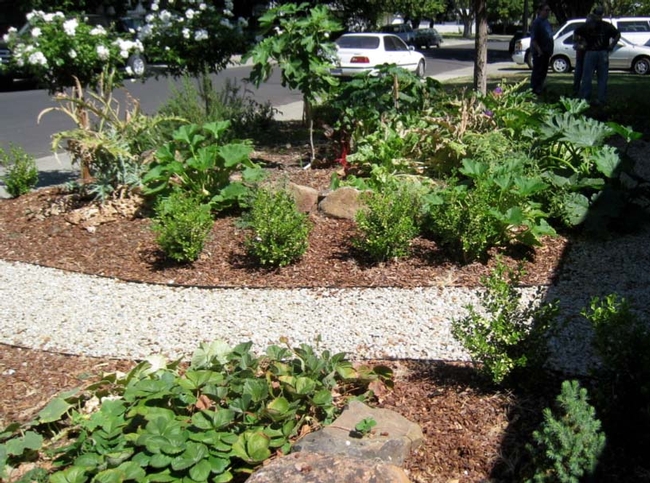
Deodara House. (photos by Marian Chmieleski)

Millward House

Wykoff House
Forest Biology Research Center opens at UC Davis
A Forest Biology Research Center has been created at UC Davis, bringing good news for students, researchers, and all of us who like to breathe clean air.
“Trees are as important as agriculture to the landscape of California and the world,” says UC Davis Department of Plant Sciences Professor David Neale, a forest geneticist and the driving force behind the new center. “Creation of the center culminates the work of many people over many years to bring a visible presence to forest biology research and education on the UC Davis campus.”
UC Davis is a prime location for forest biology research and education because of its proximity to the Sierra Nevada and coastal mountain forest ecosystems and its extensive faculty expertise in all aspects of forest biology, says UC Davis Plant Ecology Professor Mark Schwartz, director of the John Muir Institute for the Environment (JMIE) where the new center is located.
“The creation of this forest-focused center is both an affirmation of what UC Davis has been doing really well for a long time, and a big step forward in JMIE’s efforts to rally faculty expertise around the central environmental issues facing California and the world”, Schwartz says. “As California joins Europe in adopting carbon standards, developing a better understanding of the role of forests in carbon sequestration has become a priority for environmental organizations.”
The new center will also provide a framework for the cross-disciplinary work so central to forest biology.
“Forest biology draws from many of the core biological sciences such as genetics, ecology, plant pathology, entomology, plant biology, and geography,” Neale explains. “Before this framework was in place, graduate students could study genetics with me, for example, but they couldn’t really go broader into other areas of forest biology. Now when they come to UC Davis to do graduate work in, say, ecology, they will also have access to interdisciplinary work in forest biology.”
The Forest Biology Research Center is working to develop a certificate program in forest biology that can be awarded along with a degree from an existing graduate program.
At the Forest Biology Research Center website, you can learn more about the 24 UC Davis faculty and affiliated members of the US Forest Service who founded the center. They look forward to working with others to help develop forest biology research and education at UC Davis.
In addition to Neale and Schwartz, the executive committee includes UC Davis Plant Pathology Professor Dave Rizzo, UC Davis Plant Biology Professor Alison Berry, and Research Ecologist Malcolm North with the UC Davis Department of Plant Sciences.


